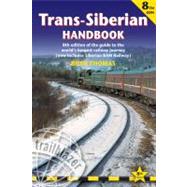
Note: Supplemental materials are not guaranteed with Rental or Used book purchases.
Purchase Benefits
What is included with this book?
The New copy of this book will include any supplemental materials advertised. Please check the title of the book to determine if it should include any access cards, study guides, lab manuals, CDs, etc.
The Used, Rental and eBook copies of this book are not guaranteed to include any supplemental materials. Typically, only the book itself is included. This is true even if the title states it includes any access cards, study guides, lab manuals, CDs, etc.
Introduction
After the classic film of Boris Pasternak’s love story,Dr Zhivago, there can be few people unaware of the magic of crossing Russia and the wild forests and steppes of Siberia on the longest railway journey in the world, the Trans-Siberian. The distances spanned are immense: almost 6000 miles, a seven-day journey, between Moscow and the Pacific port of Vladivostok (for boat connections to Japan); just under 5000 miles, five days, between Moscow and Beijing.
Since a rail service linking Europe with the Far East was established at the turn of the 19th century, foreign travellers and adventurers have been drawn to it. Most of the early travellers crossed Siberia in the comfort of the carriages of the Belgian Wagon Lits company, as luxurious as those of the Venice-Simplon Orient Express of today. Things changed somewhat after the Russian Revolution in 1917 as it became increasingly difficult for foreigners to obtain permits for Siberia. It was not until the 1960s that the situation improved and Westerners began to use the railway again for getting to Japan, taking the boat from Nakhodka (it now leaves from Vladivostok) for the last part of the journey. In the early 1980s, travel restrictions for foreigners visiting China were eased and now many people have found the Trans-Siberian a fascinating and cheap way to get to or from both the Middle Kingdom and Mongolia.
Rail travel is not only far more environmentally friendly than flying but inevitably passengers absorb something of the ethos of the country through which they travel: on this train you are guaranteed to meet local people, for this is no ‘tourist special’ but a working service; you may find yourself draining a bottle of vodka with a Russian soldier, discussing politics with a Chinese academic or drinking Russian champagne with a Mongolian trader.
Russia is undergoing phenomenal changes after decades of stagnation. While the ending of the Cold War may have removed some of the mystique of travelling in the former USSR, Russia’s increasing accessibility means that there are new travel opportunities right across the country. With foreigners no longer obliged to stay in overpriced state-run hotels, visiting the country is more affordable than ever before.
Although travel in Siberia today presents few of the dangers and difficulties that it did earlier in the last century, a journey on the Trans-Siberian still demands a considerable planning and preparation. Now in its seventh edition with even more detailed information than its predecessors, this book helps you cut through the red tape when arranging the trip, gives background information on Russia and Siberia, and provides a kilometre-by-kilometre guide to the entire route of the greatest rail adventure – the Trans-Siberian.